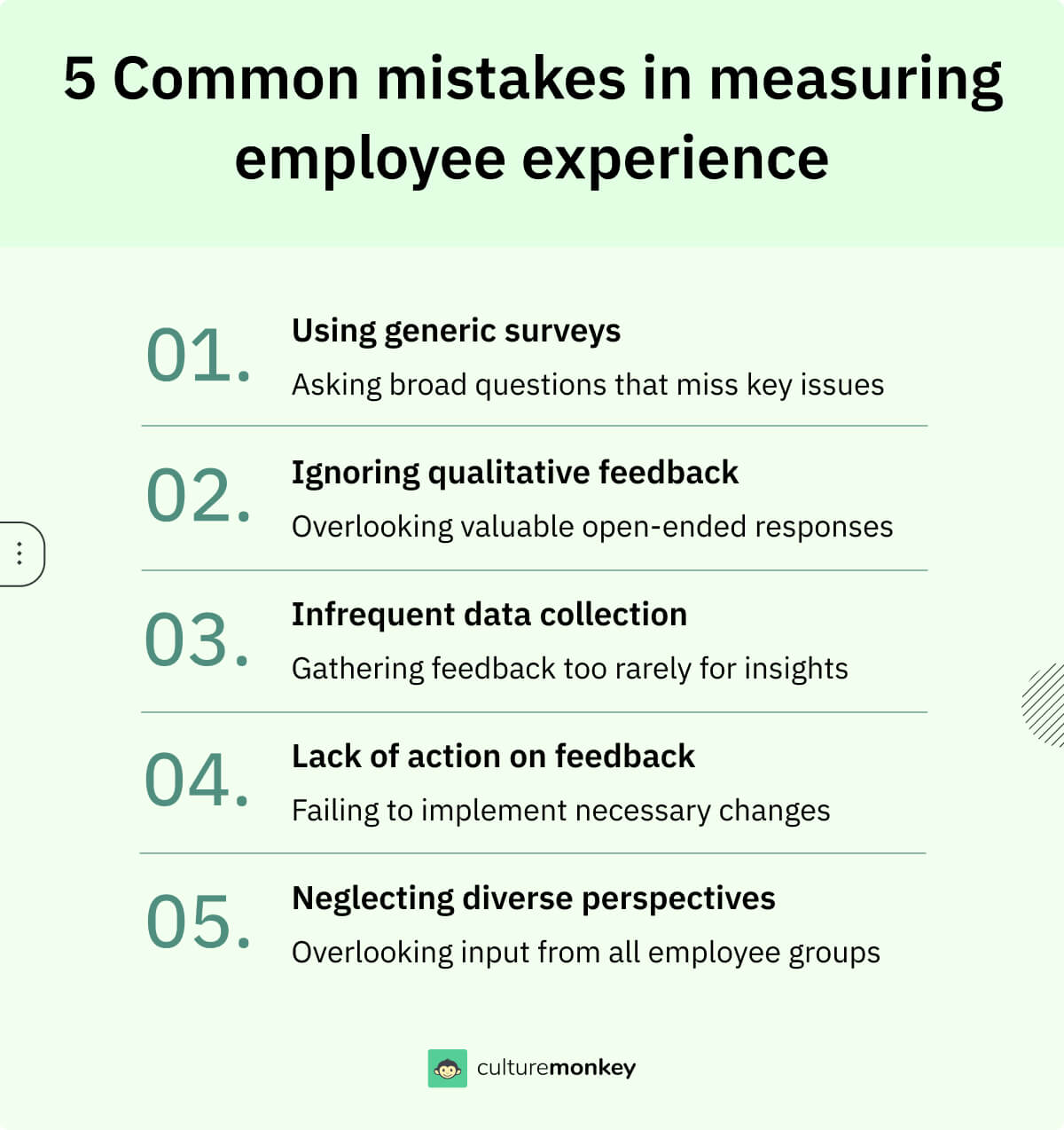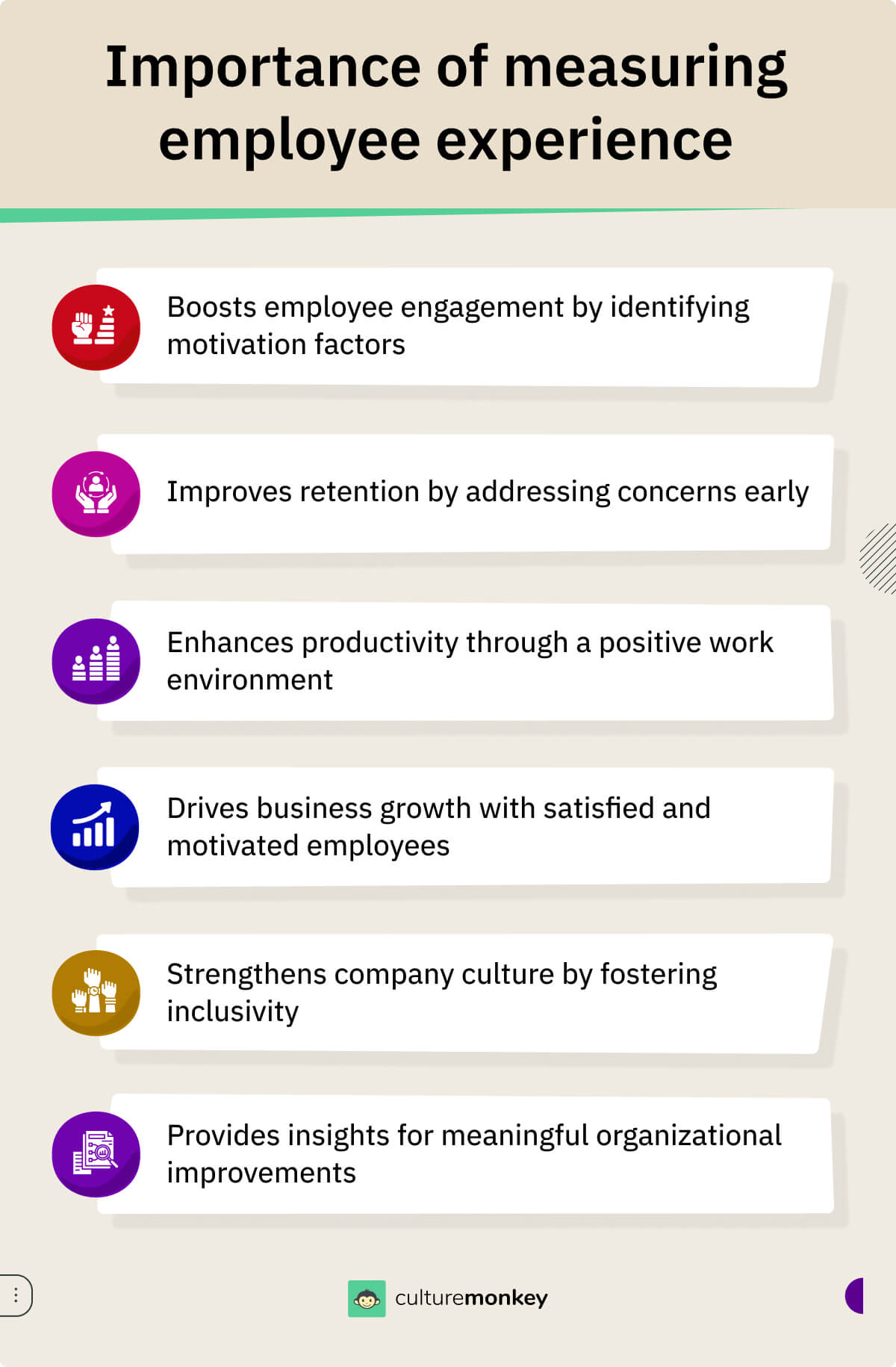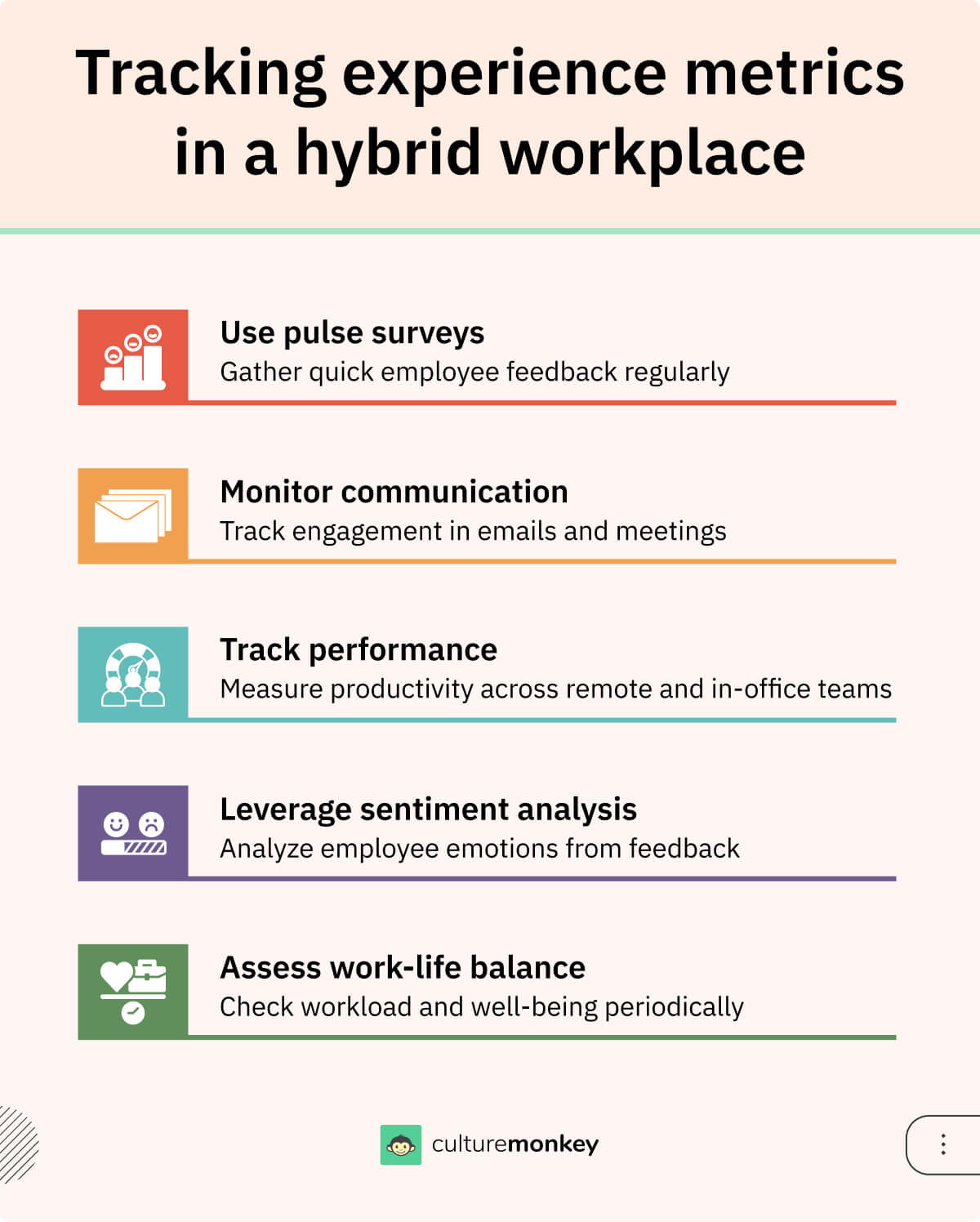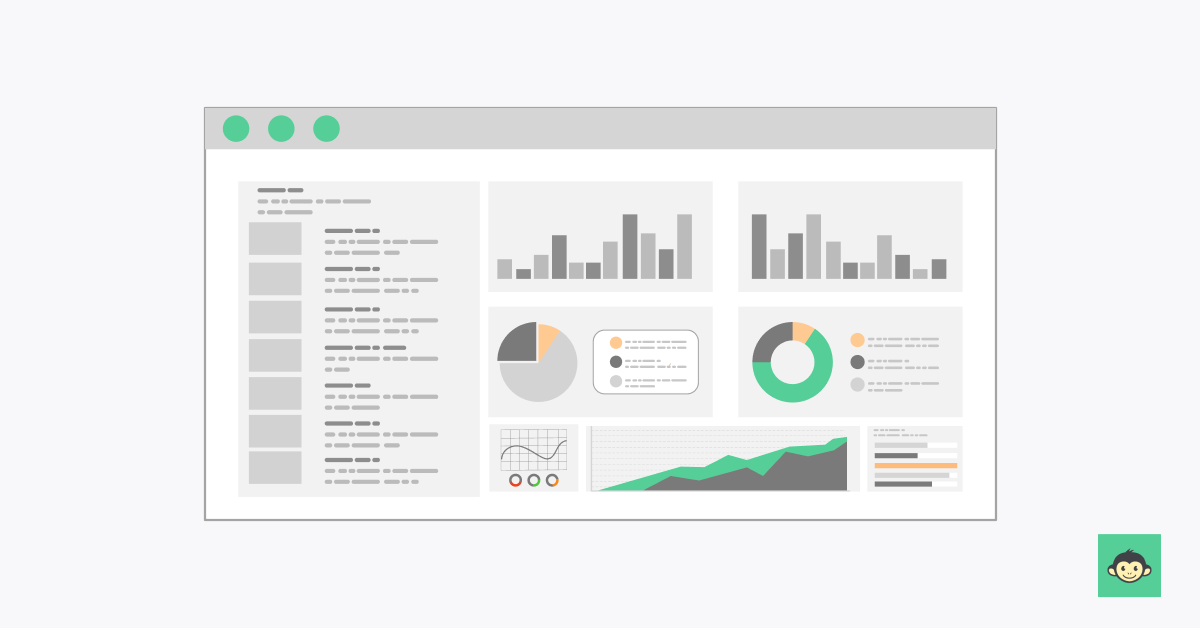13 Top employee experience metrics that matter in 2025: Best practices and strategies

Imagine this: in the 1960s, NASA was gearing up to send a man to the moon. Amidst all the cutting-edge technology and top-tier scientists, a reporter asked a janitor at the Kennedy Space Center what he was doing.
His reply? "I’m helping put a man on the moon." That single statement speaks volumes. It wasn’t just about mopping floors—it was about being part of something bigger, feeling valued, and knowing his role mattered.
Now, fast forward to today’s workplace. Just like NASA’s janitor, employees everywhere want to feel connected, appreciated, and impactful. But how do you measure something as intangible as “employee experience”?
Is it surveys, retention rates, or something more nuanced? In this blog, we’ll break it down into actionable insights for managers ready to transform their workplace.
Blog Highlights


What does employee experience mean?

Employee experience encompasses all interactions employees have during their tenure with an organization, from recruitment to offboarding. It directly impacts productivity, engagement, and retention. A positive experience starts with smooth recruitment and onboarding, supported by a collaborative work environment and inclusive culture.
Leadership plays a critical role, with clear communication, constructive feedback, and opportunities for growth driving satisfaction. Continuous learning, well-being, and work-life balance are essential for fostering engagement and retaining talent.
Recognizing employee contributions boosts morale and motivation, while open communication fosters trust and transparency. Providing efficient tools and up-to-date technology ensures employees can work effectively without unnecessary frustration.
When organizations prioritize employee experience, they create an environment where individuals feel valued, supported, and aligned with the company’s goals. This, in turn, boosts morale, encourages loyalty, and drives long-term success, making it a critical focus for any organization looking to thrive in today’s competitive landscape.



Highly engaged employees make customer experience. Disengaged employees break it.
Founder
LeaderFactor
Why should you care about measuring employee experience?

Measuring employee experience is paramount for organizations seeking sustained success and a thriving workforce.
- Understanding workplace satisfaction: Measuring employee experience uncovers key factors influencing satisfaction, enabling organizations to make targeted improvements that enhance morale and engagement.
- Boosting productivity and retention: A positive experience directly correlates with higher productivity and lower turnover, reducing recruitment costs and fostering long-term organizational stability.
- Attracting and retaining top talent: Organizations that prioritize employee well-being and growth build a strong employer brand, appealing to prospective talent and retaining current employees.
- Evaluating leadership effectiveness: Employee experience acts as a reflection of leadership impact, helping identify areas for improvement and promoting transparency and accountability.
- Aligning with business goals: By measuring and improving employee experience, organizations create a harmonious culture that aligns workforce satisfaction with broader strategic objectives, driving long-term success.
What are the 4 pillars of employee experience?

The concept of employee experience is often organized around four key pillars, which are:
- Culture and environment: A strong culture and environment are the foundation of employee experience. By fostering diversity, equity, and inclusion, organizations create a workplace where everyone feels valued and empowered to collaborate and innovate. Alongside an inclusive culture, the physical and virtual workspaces must support productivity and well-being, ensuring employees can thrive regardless of location or role.
- Technology and tools: Providing efficient, user-friendly digital tools is essential for seamless workflows and effective collaboration. A positive digital experience allows employees to focus on meaningful tasks without unnecessary friction. Additionally, leveraging automation and innovative technologies reduces manual workloads, empowering employees to engage in strategic and creative efforts that drive success.
- Career development: Continuous learning and career growth opportunities are vital for employee engagement. Offering training programs, mentorship, and clear pathways for advancement enables employees to build new skills and envision a long-term future within the organization, boosting motivation and retention.
- Well-being and work-life balance: Prioritizing employee well-being fosters a healthier, more engaged workforce. This includes wellness programs, mental health support, and initiatives that promote physical health. Flexible work policies and a supportive approach to balancing professional and personal life ensure employees can maintain harmony and avoid burnout, leading to sustained productivity and satisfaction.
Benefits of measuring employee experience

Measuring employee experience provides several benefits for organizations, contributing to improved workplace satisfaction, employee productivity, and overall organizational success. Here are some key advantages:
- Identifying areas for improvement: Measurement allows organizations to identify specific areas of the employee experience that may need attention or improvement. This could include issues related to communication, leadership, work processes, or other aspects of the workplace.
- Enhancing employee engagement: By understanding what factors contribute to a positive employee experience, organizations can tailor their strategies to enhance engagement. Engaged employees are more likely to be productive, committed, and contribute positively to the work environment.
- Reducing turnover: Measuring employee experience helps in identifying factors that may contribute to dissatisfaction or turnover. By addressing these issues proactively, organizations can reduce turnover rates and retain valuable talent.
- Increasing productivity: Employees who have a positive experience at work are generally more motivated and productive. Measurement allows organizations to identify and reinforce factors that contribute to a productive work environment, leading to improved overall performance.
- Attracting top talent: Organizations that prioritize and measure employee experience create a positive employer brand. This, in turn, can attract top talent as potential employees are drawn to workplaces that value their well-being, growth, and overall satisfaction.
- Enhancing leadership effectiveness: Measurement provides insights into leadership effectiveness. It helps leaders understand how their actions and decisions impact the workforce, enabling them to make informed adjustments to their leadership style and practices.
- Promoting continuous improvement: Regular measurement creates a feedback loop for continuous improvement. Organizations can use feedback from employees to iterate on their strategies, policies, and programs, ensuring that they remain responsive to the evolving needs and expectations of the workforce.
What are common challenges in measuring employee experience?
Measuring employee experience is essential for organizations striving to enhance engagement, productivity, and retention. However, several challenges can impede accurate assessment:
- Data integration across platforms: Organizations often use multiple systems for HR, payroll, and performance management. Consolidating data from these sources for a holistic view can be complex and time-consuming.
- Subjectivity in employee feedback: Employee perceptions are subjective, influenced by personal expectations. This can result in biased feedback, complicating accurate measurement of employee experience.
- Rapidly changing work environments: Remote and hybrid work models introduce variability, making it challenging to maintain consistent and reliable employee experience measurements.

- Cultural differences: Multinational organizations face challenges with cultural variations, which can influence how employees perceive and report their experiences, complicating standardized measurement.
- Employee engagement fatigue: Overuse of surveys and feedback requests can disengage employees, leading to reduced response rates and less reliable data over time.
- Lack of actionable insights: Data collection without a clear analysis and action plan can undermine efforts, as organizations may struggle to translate insights into meaningful improvements.
- Confidentiality concerns: Employees may fear retribution or doubt confidentiality, leading to less honest feedback and skewed data that doesn’t accurately reflect employee experience.
- Difficulty in linking metrics to outcomes: Aligning employee experience metrics with organizational performance goals can be challenging, making it harder to demonstrate the tangible benefits of improvement initiatives.
How do we measure employee experience?

Measuring employee experience involves a combination of quantitative and qualitative methods to gain a comprehensive understanding of various aspects of the employee lifecycle. Here are common approaches to measuring employee experience:
- Surveys and feedback: Conduct regular employee surveys to collect quantitative data on employee satisfaction, engagement, and specific aspects of the work environment. Use targeted questions to assess different dimensions, such as leadership, communication, and workplace culture. Open-ended questions allow employees to provide qualitative insights.
- Pulse surveys: Implement short and frequent pulse surveys to capture real-time feedback on specific issues or changes within the organization. These quick surveys provide a more dynamic and immediate understanding of employee sentiments.
- Focus groups and interviews: Organize focus groups or one-on-one interviews to delve deeper into specific topics or gather qualitative insights. These methods allow employees to express their opinions in more detail, providing a richer understanding of their experiences.
- Performance metrics: Analyze performance metrics, including productivity levels, project completion rates, and other relevant key performance indicators (KPIs). Changes in these metrics can indicate the impact of the overall employee experience on organizational outcomes.
- 360-Degree feedback: Implement a 360-degree feedback system where employees receive input from peers, subordinates, and supervisors. This comprehensive approach provides a holistic view of an employee's performance and interpersonal skills.
- Exit interviews: Conduct thorough exit interviews to understand the reasons behind employee departures. Insights gained from exit interviews can highlight areas of improvement and potential challenges within the organization.
- Employee net promoter score (eNPS): Similar to the Net Promoter Score used in customer experience, eNPS measures the likelihood of employees recommending the organization as a good place to work. It provides a simple but effective quantitative metric.
- Social listening: Monitor social media platforms and internal communication channels to understand how employees perceive the company. Social listening tools can help identify emerging trends and concerns within the workforce.
- Attendance and turnover rates: Analyze attendance patterns and turnover rates. Sudden increases in absenteeism or turnover can indicate dissatisfaction or issues within the workplace.
- Technology analytics: Use analytics from collaboration tools, project management software, and other workplace technologies to gain insights into how employees are utilizing these tools and identify areas for improvement.

How to measure digital employee experience?

Measuring digital employee experience (DEX) is crucial for organizations to ensure that their technological tools and platforms effectively support employee productivity and engagement. Beyond traditional methods, consider the following advanced strategies:
- Application performance monitoring: The tools track the performance of software applications used by employees, identifying issues such as slow load times or errors that can hinder productivity. By monitoring these metrics, organizations can proactively address technical problems that negatively impact the digital experience.
- Digital experience monitoring: The solutions provide real-time insights into the end-user experience by analyzing interactions with digital tools. This includes monitoring response times, transaction success rates, and user behavior analytics to asess the efficiency and effectiveness of digital workflows.
- User behavior analytics: It involves analyzing patterns in how employees interact with digital systems. By understanding common behaviors and identifying anomalies, organizations can optimize interfaces and processes to better align with user needs and preferences.
- Digital adoption platforms: They assist in measuring how effectively employees utilize digital tools by tracking feature usage and providing in-app guidance. This helps in identifying training needs and ensuring that employees are fully leveraging available technologies.
- Experience sampling method: It involves prompting employees at random intervals to provide immediate feedback on their digital interactions. This real-time data collection captures contextual insights into the digital experience, allowing for timely interventions.
- Network performance monitoring: The tools assess the reliability and speed of the network infrastructure supporting digital tools. By ensuring robust connectivity, organizations can prevent disruptions that adversely affect the digital employee experience.
- Sentiment analysis of digital communications: Applying sentiment analysis to internal digital communications, such as emails and chat messages, can gauge employee morale and satisfaction related to digital tools, uncovering areas for improvement.
13 Top employee experience KPIs to measure

Key Performance Indicators (KPIs) are essential for quantifying and assessing various aspects of the employee experience. Here are 13 top employee experience KPIs to measure:
- Employee engagement score: Calculate an overall engagement score based on surveys or assessments that measure employees' emotional commitment, motivation, and satisfaction with their work.
- Retention rate: Track the percentage of employees who stay with the organization over a specific period. A high retention rate indicates a positive employee experience.
- Net promoter score (eNPS): Determine the likelihood of employees recommending the organization as a great place to work. The eNPS score reflects overall satisfaction and advocacy.
- Performance and productivity metrics: Measure individual and team performance metrics to gauge how effectively employees are contributing to organizational goals.
- Employee satisfaction score (ESS): Assess overall satisfaction through surveys or questionnaires, covering various aspects of the work environment, culture, and leadership.
- Training and development participation: Monitor the participation rates in training and development programs. High participation indicates a commitment to continuous learning and development.
- Leadership effectiveness score: Evaluate leadership effectiveness through surveys or 360-degree feedback to measure how well leaders inspire, communicate, and support their teams.
- Diversity and inclusion metrics: Track diversity and inclusion KPIs, including the representation of different demographic groups and the effectiveness of inclusion initiatives.
- Well-being index: Measure employees' well-being using indicators such as stress levels, work-life balance, and access to wellness programs.
- Employee recognition and awards: Monitor the frequency and effectiveness of employee recognition programs. The number of awards and the diversity of recipients can indicate a positive employee experience.
- Promotion and advancement rates: Analyze the rate at which employees are promoted or advanced within the organization. This reflects opportunities for career growth and development.
- Absenteeism rate: Track the frequency and reasons for employee absences. A sudden increase in absenteeism may indicate dissatisfaction or burnout.
- Team collaboration and communication: Assess how well teams collaborate and communicate using metrics from collaboration tools and feedback on internal communication processes.

Unlock the secrets
to a better workplace
Discover 20 essential questions to gain valuable insights, boost engagement, and create a thriving work environment.
8 Best practices to improve employee experience KPIs

Improving employee experience KPIs involves a holistic approach that addresses various aspects of employee recruitment strategy in the workplace. Here are 10 best practices and strategies to enhance your employee experience KPIs:
- Regularly collect and act on feedback: Implement regular surveys, pulse checks, and feedback mechanisms to understand employee sentiments. Act on the feedback received, demonstrating a commitment to continuous improvement.
- Prioritize employee well-being: Invest in well-being programs, mental health support, and initiatives that promote a healthy work-life balance. A focus on well-being contributes to increased satisfaction and productivity.
- Provide learning and development opportunities: Offer continuous learning opportunities and career development programs. Empower employees to enhance their skills and advance within the organization, positively impacting engagement and retention.
- Strengthen leadership and management skills: Provide leadership training to enhance the skills of managers and leaders. Effective leadership fosters a positive work culture, improves communication, and positively influences employee engagement.
- Promote inclusivity and diversity: Foster an inclusive and diverse workplace. Implement policies and initiatives that promote equity and create an environment where all employees feel valued and included.
- Recognize and reward performance: Establish a robust employee recognition program that acknowledges and rewards outstanding performance. Recognition fosters a positive work environment and motivates employees to excel.
- Enhance communication channels: Improve communication channels to ensure transparent and timely information flow. Clear communication fosters trust and alignment with organizational goals.
- Invest in technology and tools: Provide employees with modern, efficient tools and technology. Streamlining processes and workflows contributes to a positive digital experience and increased productivity.

How employee experience platforms ensure accurate measurement?

An employee experience platform plays a pivotal role in measuring employee experience accurately and comprehensively. By consolidating various tools and feedback mechanisms onto a single platform, it provides a centralized hub for gathering, analyzing, and acting upon data related to employee satisfaction, employee engagement surveys, and overall workplace sentiment.
One key significance lies in the platform's ability to facilitate real-time feedback through surveys and pulse checks. This immediacy allows organizations to promptly address emerging issues, fostering a proactive approach to employee experience management.
An employee experience platform enables the tracking of diverse KPIs, providing a holistic view of the workforce's sentiments and engagement levels. This comprehensive data empowers organizations to identify patterns, trends, and areas for improvement with greater precision.
These platforms often offer analytics and reporting functionalities, allowing for in-depth analysis of employee experience metrics. By visualizing trends and correlations, organizations can make informed decisions and strategic interventions to enhance the overall employee journey.
Ultimately, an employee experience platform not only streamlines the measurement process but also amplifies the organization's ability to create a workplace that aligns with the evolving expectations and needs of team members and its workforce.
Conclusion
Prioritizing and measuring employee experience is paramount for fostering a positive and productive work environment. The multifaceted nature of employee experience encompasses factors such as culture, leadership, technology, and well-being.
Through systematic measurement of employee experiences using surveys, KPIs, and feedback mechanisms, organizations can gain valuable insights into the nuances of their workforce's satisfaction and engagement.
The significance of an employee experience platform like CultureMonkey further elevates this process by providing a centralized and dynamic approach to data collection, analysis, and intervention, enabling organizations to proactively enhance engagement, satisfaction, and overall employee well-being.
Summary
Measuring employee experience metrics helps organizations understand the overall satisfaction, engagement, and well-being of their workforce. These metrics assess key factors such as workplace culture, career development, and employee perception of leadership and support.
By leveraging data-driven insights, organizations can identify improvement areas, enhance the employee journey, and create a more supportive and productive work environment. This ultimately leads to higher retention, improved performance, and long-term business success.
FAQs
1. How do surveys help in measuring employee experience?
Surveys provide a structured way to gather employee feedback on their experiences, satisfaction, and needs. They help identify patterns, pinpoint issues, and evaluate workplace factors like culture, leadership, and well-being. Regular, anonymous surveys foster transparency, encourage honest input, and provide actionable insights to enhance the overall employee experience, boosting engagement and organizational success significantly.
2. How can organizations track employee experience over time?
Organizations can track employee experience through continuous feedback systems, regular surveys, and performance reviews. Metrics like engagement scores, retention rates, and well-being indexes help monitor trends effectively. Tools such as employee experience platforms provide real-time insights, allowing organizations to identify changes, address concerns promptly, and maintain alignment with evolving employee expectations, promoting long-term organizational stability.
3. Can employee experience be measured during onboarding?
Yes, measuring employee experience during onboarding is crucial. Surveys and feedback forms can capture first impressions, assess the effectiveness of training, and identify onboarding gaps and challenges early. By evaluating the process, organizations can enhance onboarding strategies, ensure smooth integration, and create a strong foundation for long-term employee satisfaction, engagement, and retention across all roles.
4. How can data from experience measurement improve retention and performance?
Experience measurement data identifies key factors driving satisfaction and dissatisfaction, enabling targeted improvements effectively. Addressing concerns like work-life balance, career growth, and leadership effectiveness boosts engagement and reduces turnover rates significantly. Enhanced employee experience fosters loyalty, motivation, and productivity, ultimately improving retention and driving overall organizational performance, innovation, and sustained competitive advantage.
5. How do you measure employee satisfaction as part of the experience?
Employee satisfaction can be measured through surveys, pulse checks, and feedback forms focusing on work environment, leadership, and personal growth opportunities. Metrics like eNPS (Employee Net Promoter Score) and engagement scores provide actionable insights into satisfaction levels. Analyzing trends helps organizations identify areas for improvement and create a more fulfilling employee experience, driving motivation and team cohesion effectively.
6. How do you measure employee experience?
Employee experience is measured using surveys, pulse checks, and feedback tools to gather insights on satisfaction, engagement, and well-being. Additional methods include analyzing key metrics like retention rates, productivity, and eNPS (Employee Net Promoter Score). Advanced techniques, such as journey mapping, sentiment analysis, and digital experience monitoring, provide deeper insights, enabling organizations to address challenges and improve experiences effectively.




